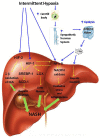Obstructive sleep apnea and non-alcoholic Fatty liver disease: is the liver another target?
- PMID: 23087670
- PMCID: PMC3473309
- DOI: 10.3389/fneur.2012.00149
Obstructive sleep apnea and non-alcoholic Fatty liver disease: is the liver another target?
Abstract
Obstructive sleep apnea (OSA) is recurrent obstruction of the upper airway during sleep leading to intermittent hypoxia (IH). OSA has been associated with all components of the metabolic syndrome as well as with non-alcoholic fatty liver disease (NAFLD). NAFLD is a common condition ranging in severity from uncomplicated hepatic steatosis to steatohepatitis (NASH), liver fibrosis, and cirrhosis. The gold standard for the diagnosis and staging of NAFLD is liver biopsy. Obesity and insulin resistance lead to liver steatosis, but the causes of the progression to NASH are not known. Emerging evidence suggests that OSA may play a role in the progression of hepatic steatosis and the development of NASH. Several cross-sectional studies showed that the severity of IH in patients with OSA predicted the severity of NAFLD on liver biopsy. However, neither prospective nor interventional studies with continuous positive airway pressure treatment have been performed. Studies in a mouse model showed that IH causes triglyceride accumulation in the liver and liver injury as well as hepatic inflammation. The mouse model provided insight in the pathogenesis of liver injury showing that (1) IH accelerates the progression of hepatic steatosis by inducing adipose tissue lipolysis and increasing free fatty acids (FFA) flux into the liver; (2) IH up-regulates lipid biosynthetic pathways in the liver; (3) IH induces oxidative stress in the liver; (4) IH up-regulates hypoxia inducible factor 1 alpha and possibly HIF-2 alpha, which may increase hepatic steatosis and induce liver inflammation and fibrosis. However, the role of FFA and different transcription factors in the pathogenesis of IH-induced NAFLD is yet to be established. Thus, multiple lines of evidence suggest that IH of OSA may contribute to the progression of NAFLD but definitive clinical studies and experiments in the mouse model have yet to be done.
Keywords: intermittent hypoxia; non-alcoholic fatty liver disease; non-alcoholic steatohepatitis; sleep apnea.
Figures


Similar articles
-
Hepatocyte HIF-1 and Intermittent Hypoxia Independently Impact Liver Fibrosis in Murine Nonalcoholic Fatty Liver Disease.Am J Respir Cell Mol Biol. 2021 Oct;65(4):390-402. doi: 10.1165/rcmb.2020-0492OC. Am J Respir Cell Mol Biol. 2021. PMID: 34003729 Free PMC article.
-
Nocturnal hypoxia-induced oxidative stress promotes progression of pediatric non-alcoholic fatty liver disease.J Hepatol. 2016 Sep;65(3):560-9. doi: 10.1016/j.jhep.2016.04.010. Epub 2016 Aug 5. J Hepatol. 2016. PMID: 27501738 Free PMC article.
-
Chronic intermittent hypoxia contributes to non-alcoholic steatohepatitis progression in patients with obesity.Hepatol Int. 2022 Aug;16(4):824-834. doi: 10.1007/s12072-022-10347-2. Epub 2022 Jun 6. Hepatol Int. 2022. PMID: 35668285
-
Obstructive sleep apnea, intermittent hypoxia and non-alcoholic fatty liver disease.Sleep Med. 2022 Jul;95:16-28. doi: 10.1016/j.sleep.2022.04.006. Epub 2022 Apr 18. Sleep Med. 2022. PMID: 35537279 Review.
-
Association of Obstructive Sleep Apnea with Nonalcoholic Fatty Liver Disease: Evidence, Mechanism, and Treatment.Nat Sci Sleep. 2024 Jul 8;16:917-933. doi: 10.2147/NSS.S468420. eCollection 2024. Nat Sci Sleep. 2024. PMID: 39006248 Free PMC article. Review.
Cited by
-
Chenodeoxycholic Acid Reduces Hypoxia Inducible Factor-1α Protein and Its Target Genes.PLoS One. 2015 Jun 22;10(6):e0130911. doi: 10.1371/journal.pone.0130911. eCollection 2015. PLoS One. 2015. PMID: 26098428 Free PMC article.
-
Early-life physical activity reverses metabolic and Foxo1 epigenetic misregulation induced by gestational sleep disturbance.Am J Physiol Regul Integr Comp Physiol. 2015 Mar 1;308(5):R419-30. doi: 10.1152/ajpregu.00426.2014. Epub 2015 Jan 7. Am J Physiol Regul Integr Comp Physiol. 2015. PMID: 25568076 Free PMC article.
-
Obstructive Sleep Apnea Is Associated With Altered Glycemic Patterns in Pregnant Women With Obesity.J Clin Endocrinol Metab. 2019 Jul 1;104(7):2569-2579. doi: 10.1210/jc.2019-00159. J Clin Endocrinol Metab. 2019. PMID: 30794722 Free PMC article.
-
Association of IRS1 (Gly972Arg) and IRS2 (Gly1057Asp) genes polymorphisms with OSA and NAFLD in Asian Indians.PLoS One. 2021 Aug 27;16(8):e0245408. doi: 10.1371/journal.pone.0245408. eCollection 2021. PLoS One. 2021. PMID: 34449768 Free PMC article.
-
Sleep Apnea, Hypoxia Inducible Factor, and Fatty Liver: More Questions Than Answers?Am J Respir Cell Mol Biol. 2021 Oct;65(4):337-338. doi: 10.1165/rcmb.2021-0204ED. Am J Respir Cell Mol Biol. 2021. PMID: 34101539 Free PMC article. No abstract available.
References
-
- Bao G., Metreveli N., Li R., Taylor A., Fletcher E. C. (1997). Blood pressure response to chronic episodic hypoxia: role of the sympathetic nervous system. J. Appl. Physiol. 83, 95–101 - PubMed
LinkOut - more resources
Full Text Sources

